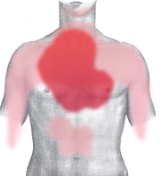
Myocardial infarction
Overview
Myocardial infarction or acute myocardial infarction (AMI), commonly known as a heart attack, results from the interruption of blood supply
to a part of the heart
, causing heart cells to die. This is most commonly due to occlusion (blockage) of a coronary artery following the rupture of a vulnerable atherosclerotic plaque
, which is an unstable collection of lipids (cholesterol and fatty acids) and white blood cell
s (especially macrophage
s) in the wall of an artery
.
Blood flow
Blood flow is the continuous running of blood in the cardiovascular system.The human body is made up of several processes all carrying out various functions. We have the gastrointestinal system which aids the digestion and the absorption of food...
to a part of the heart
Heart
The heart is a myogenic muscular organ found in all animals with a circulatory system , that is responsible for pumping blood throughout the blood vessels by repeated, rhythmic contractions...
, causing heart cells to die. This is most commonly due to occlusion (blockage) of a coronary artery following the rupture of a vulnerable atherosclerotic plaque
Vulnerable plaque
A vulnerable plaque is a kind of atheromatous plaque – a collection of white blood cells and lipids in the wall of an artery - that is particularly unstable and prone to produce sudden major problems, such as a heart attack or stroke.In many cases, a vulnerable plaque has a thin fibrous cap and a...
, which is an unstable collection of lipids (cholesterol and fatty acids) and white blood cell
White blood cell
White blood cells, or leukocytes , are cells of the immune system involved in defending the body against both infectious disease and foreign materials. Five different and diverse types of leukocytes exist, but they are all produced and derived from a multipotent cell in the bone marrow known as a...
s (especially macrophage
Macrophage
Macrophages are cells produced by the differentiation of monocytes in tissues. Human macrophages are about in diameter. Monocytes and macrophages are phagocytes. Macrophages function in both non-specific defense as well as help initiate specific defense mechanisms of vertebrate animals...
s) in the wall of an artery
Artery
Arteries are blood vessels that carry blood away from the heart. This blood is normally oxygenated, exceptions made for the pulmonary and umbilical arteries....
.
Unanswered Questions
Discussions

